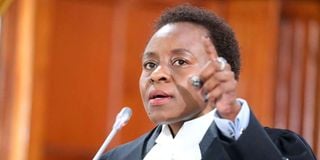Premium
Raila’s legal team tables evidence on election rigging

Ms Julie Soweto, one of the lawyers representing Azimio presidential candidate Raila Odinga, making he submissions at the Supreme Court, Milimani on September 2, 2022.
Azimio la Umoja One Kenya presidential candidate Raila Odinga Friday maintained that the August 9 presidential poll was rigged, as his legal team was allowed to present new evidence to show that the electoral agency’s final result was flawed.
In a live demonstration to the Supreme Court judges, Mr Odinga’s lawyers claimed that one voter identification kit was used to transmit results from two polling stations hundreds of kilometres apart.
His lawyers also showed judges what they insisted were mathematical errors in some polling stations, arguing that the Independent Electoral and Boundaries Commission (IEBC) used cooked figures to declare William Ruto the president-elect.
The presentations were made as Mr Odinga’s team argued that any violation of the constitution is enough ground for the Supreme Court to nullify an election.
Lawyer James Orengo, leading Mr Odinga’s team, said that the IEBC has not asked the Supreme Court to strike out his client’s petition.
He argued that in 2017 when the same court nullified a presidential election, the judges warned the IEBC that they would not hesitate to take sanctions against the agency if another petition is presented regarding the same issues that informed their verdict.
Serial numbers
Ms Julie Soweto, one of Mr Odinga’s lawyers, told the judges that the same voter identification kit transmitted results from stream three of Thunguma Primary School in Nyeri and sent data from Psongoywo Primary School in Bungoma County.
Ms Soweto said the serial number of the voter identification kits from the two polling stations was the same.
Each voter identification kit was to have a unique serial number and to be deployed to only one polling station.
On the IEBC portal, results from Psongoywo were transmitted seven minutes after the numbers from Thunguma.
Lawyers for the IEBC and Dr Ruto protested at the presentation, and were only allocated time to respond after the Supreme Court judges determined that the forms sampled had not been submitted by Mr Odinga’s legal team as evidence in their petition.
IEBC lawyer Mahat Somane said that there was an error when generating serial numbers, which led to two different kits sharing a serial number.
“It was an error that originated at the time of serialisation. But we want to tell the court that those Kiems kits have different International Mobile Equipment Identity (IMEI) number, different Internet Protocol (IP) addresses, different polling station. We acknowledge that was an error,” Mr Somane said.
Mr Somane dismissed Ms Soweto’s claims that Venezuelan Jose Camargo intercepted results transmission forms sent from voter identification kits to the IEBC’s portal, and replaced them with manipulated documents.
In what initially appeared to be a bombshell revelation, Ms Soweto said that Mr Camargo’s name appeared on the overlay was a piece of evidence mistakenly left behind by the Venezuelan national.
“This person (Mr Camargo) is the one who was interfering with the forms. A crumb was left. By God's grace, we found something. We didn't make this up. This, my Lords, is how the staging was happening,” Ms Soweto said.
Mr Fred Ngatia, leading Dr Ruto’s legal team, argued that the form Ms Soweto had used in her demonstration had no security features.
“The form (34A) before you has a security feature, but does not have the name of Jose Camargo. All those things were meant to deceive, to mislead particularly such eminent lawyers. Let this case be decided on factual points and factual contestation,” Mr Ngatia said.
Uploaded
Mr Somane said that the document with Mr Camargo’s name was a Quick Response (QR) register, which accompanied ballot papers to all polling stations across the country.
The IEBC lawyer presented the original form in court to prove that it did not have Mr Camargo’s name, opening another can of worms in the process.
Mr Philip Murgor, another of Mr Odinga’s lawyers, revealed to the court that the form had been signed by an UDA agent two days before the election.
Deputy Chief Justice Philomena Mwilu pointed out that an ODM candidate had also listed August 7 as his signing date. The judge queried whether both agents may have made honest mistakes when noting the date.
Mismatched tallies
The same form was cited by Mr Odinga’s lawyers for having mismatched tallies.
Summing of the votes each presidential candidate got gave a total of 316, which was five ballots less than what the IEBC listed as the number of valid votes cast.
“From where I am, the IEBC stamp looking like it has been superimposed over another stamp. We have been asked to show how the figures change. If we look at the votes cast, the first figure is for Raila Odinga, 55 votes. Ruto, 260. Mwaure, 1 and Wajackoyah, 0. If we sum up the total votes we get 316. The total votes cast as per this form is 321. Different from what we have seen,” Ms Soweto told the judges in her presentation.
The IEBC’s lawyers did not respond to the variance between the listed number of valid ballots cast and the tally of each candidate’s votes.
Dr Ruto’s lawyers claimed that Mr Odinga’s team was trying to confuse the judges by presenting unverified forms.
Mr Odinga’s lawyers remained insisted the election was rigged, claiming that 11,000 results transmission forms were uploaded from the same device within eight minutes during the tallying of votes.







